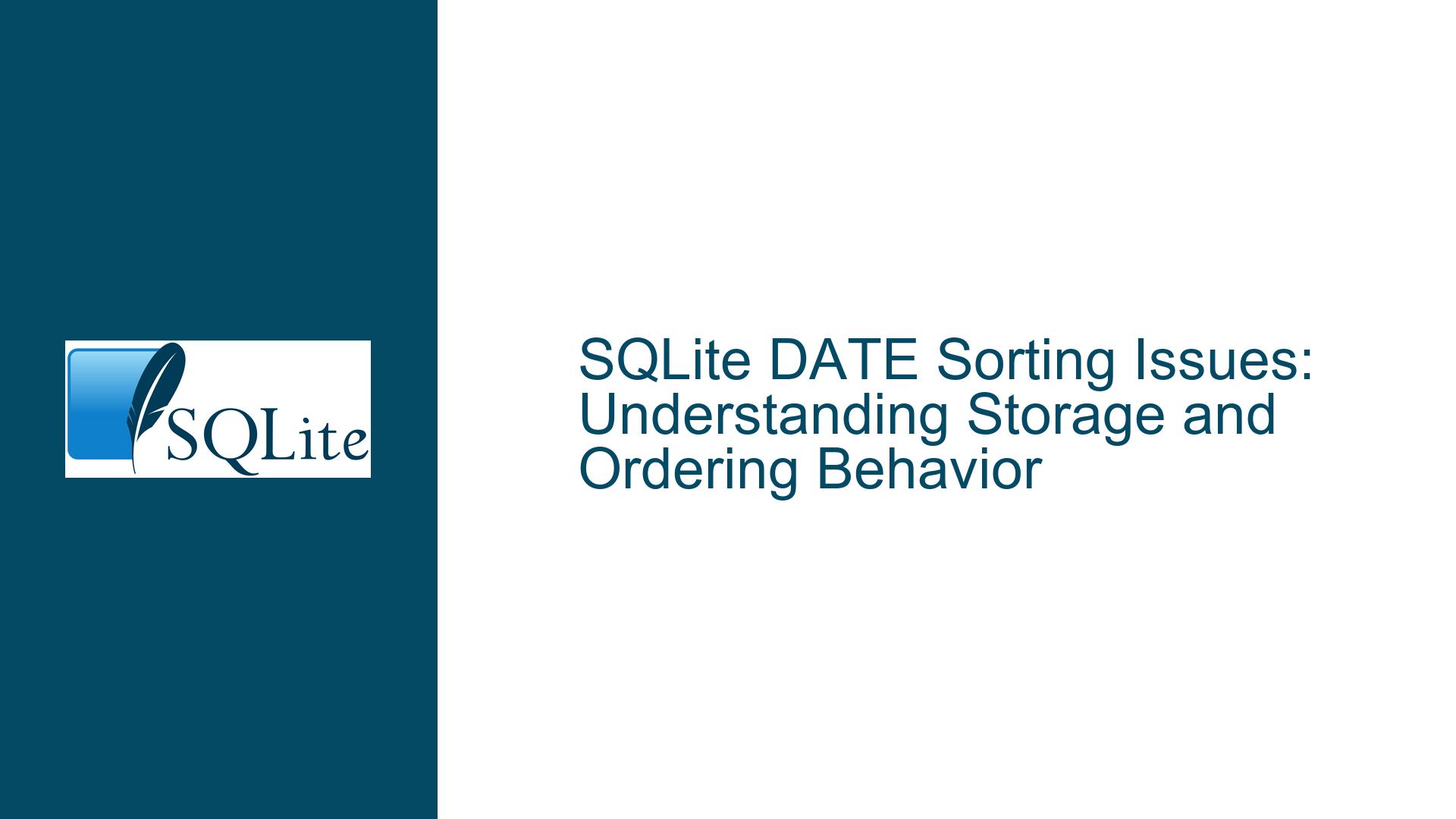SQLite DATE Sorting Issues: Understanding Storage and Ordering Behavior
Understanding the Misconception of DATE Type and Sorting Behavior in SQLite
Issue Overview
The core challenge revolves around a column defined with the affinity DATE in a SQLite database which, when sorted using ORDER BY, does not behave as expected for chronological ordering. The votehistory table includes an electionDate column declared as DATE NOT NULL, with values stored in the MM/DD/YYYY format. Attempting to sort records by electionDate using a straightforward ORDER BY electionDate query fails to produce correct chronological results. Instead, the sorting treats the dates as lexicographical (text) values, leading to an order that aligns with string comparison rules rather than temporal ones. For example, a date like 12/31/2020 would sort after 01/01/2021 because the string "12" (from 12/31/2020) is lexicographically greater than "01" (from 01/01/2021). This behavior contradicts the user’s expectation that declaring a column as DATE would inherently enable date-specific sorting logic.
The root of this confusion stems from SQLite’s unique approach to data typing. Unlike most relational databases, SQLite employs a dynamic type system where column types are affinities rather than rigidly enforced data types. The DATE affinity does not enforce storage as a date-specific binary format (e.g., a timestamp integer). Instead, values are stored as TEXT, INTEGER, or REAL based on their input format. In this case, the MM/DD/YYYY strings are stored as TEXT, and SQLite’s sorting operates purely on their textual representation. This design grants flexibility but introduces pitfalls when developers assume traditional date-type handling.
Possible Causes
Misinterpretation of SQLite’s Type Affinity System
A common misconception is that declaring a column asDATEenforces date-specific storage and comparison semantics. However, SQLite does not have built-in date or time types. TheDATEkeyword is treated as a type affinity, which loosely suggests that values should be stored in a format compatible with date/time interpretations. The actual storage format and comparison behavior depend entirely on how the data is inserted. If dates are stored asMM/DD/YYYYstrings, they are treated as plain text, and their sorting follows alphabetical rules, not chronological ones.Non-ISO Date Formatting
TheMM/DD/YYYYformat is not inherently sortable as text because its components are ordered from smallest to largest temporal unit (month, day, year). Lexicographical sorting prioritizes the leftmost characters, so01/01/2021("01...") sorts before12/31/2020("12..."), even though 2020 precedes 2021. In contrast, the ISO-8601 format (YYYY-MM-DD) orders units from largest to smallest, ensuring that textual sorting aligns with chronological order. For example,2020-12-31sorts before2021-01-01because the year"2020"precedes"2021".Lack of Validation or Conversion During Data Insertion
SQLite does not automatically validate or convert date strings into a standardized format. If applications insert dates asMM/DD/YYYYwithout normalization, the database will store them verbatim. Without constraints or triggers to enforce formatting, the column becomes a free-form text field, leaving sorting and comparison logic vulnerable to formatting inconsistencies.
Troubleshooting Steps, Solutions & Fixes
Step 1: Migrate Existing Data to ISO-8601 Format
To resolve sorting issues, existing MM/DD/YYYY values in the electionDate column must be converted to the ISO-8601 format (YYYY-MM-DD). This ensures that lexicographical sorting matches chronological order. The conversion can be performed using SQLite’s string manipulation functions. For example:
UPDATE votehistory
SET electionDate =
substr(electionDate, 7, 4) || '-' ||
substr(electionDate, 1, 2) || '-' ||
substr(electionDate, 4, 2);
This query extracts the year, month, and day from the original MM/DD/YYYY string and reconstructs it as YYYY-MM-DD. After this migration, an ORDER BY electionDate query will sort dates correctly.
Step 2: Enforce ISO-8601 Format for Future Inserts
Modify application logic or database constraints to ensure new electionDate values adhere to the ISO-8601 standard. Options include:
- Application-Side Validation: Ensure all applications writing to the database format dates as
YYYY-MM-DDbefore insertion. - SQLite CHECK Constraints: Add a constraint to the table definition to reject non-compliant dates:
CREATE TABLE votehistory (
voterId INTEGER NOT NULL,
county TEXT NOT NULL,
electionDate TEXT NOT NULL CHECK (
electionDate GLOB '[0-9][0-9][0-9][0-9]-[0-9][0-9]-[0-9][0-9]'
),
electionType TEXT NOT NULL,
historyCode TEXT NOT NULL
);
The CHECK constraint uses a GLOB pattern to enforce the YYYY-MM-DD format.
Step 3: Utilize SQLite’s Date/Time Functions
Once dates are stored in ISO-8601 format, leverage SQLite’s built-in date/time functions (e.g., DATE(), STRFTIME()) for advanced operations. For example:
-- Filter records from January 2021:
SELECT * FROM votehistory
WHERE strftime('%Y-%m', electionDate) = '2021-01';
These functions parse ISO-formatted dates correctly and enable date arithmetic, comparisons, and formatting.
Step 4: Update Queries and Indexes
After migrating the data, review existing queries to remove unnecessary string manipulations (e.g., substr() calls). Additionally, create indexes on the electionDate column to optimize sorting and filtering:
CREATE INDEX idx_votehistory_electionDate ON votehistory(electionDate);
Indexes on properly formatted dates significantly improve query performance for temporal operations.
Step 5: Educate Stakeholders on SQLite’s Typing Behavior
Developers and database administrators working with SQLite must understand its type affinity system to avoid similar issues. Key takeaways include:
- Columns declared as
DATE,DATETIME, or similar are merely hints (affinities) and do not enforce storage formats. - Always store dates in ISO-8601 for reliable sorting and compatibility with date/time functions.
- Implement validation at the application or database layer to ensure data consistency.
By addressing these areas, the votehistory table’s electionDate column will function as a chronologically sortable field, aligning with user expectations and enabling efficient date-based queries.






